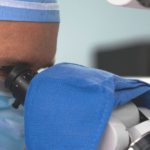
After a mastectomy, many women choose to undergo breast reconstruction surgery. In fact, older studies show that about half of women who have received a mastectomy opt for reconstruction afterwards.
Of course, not all methods of breast reconstruction are equal. Breast reconstruction methods can range from traditional implants to using the patient’s own tissue (referred to as “tissue-based reconstruction”) to recreate the affected breast. For tissue-based procedures, there are several approaches to choose from, ranging from using tissue from the abdomen, the thighs, buttocks, and even the upper part of the back, a procedure called the latissimus dorsi flap, or LAT flap procedure.
What Is a Latissimus Flap Reconstruction?
A latissimus flap reconstruction procedure works by harvesting the tissue below your shoulder blade towards the middle of your back, including some of the latissimus dorsi muscle. This approach usually takes three to four hours to perform.
During the procedure, the muscle, skin, and fat harvested from the latissimus dorsi muscle in the back are gently tunneled forward towards the breast area while keeping the blood vessels intact. This approach produces natural-looking results, despite minor differences between skin from the back and skin from the breast.
Am I a Candidate for Latissimus Flap Reconstruction?
While abdominal and thigh tissue reconstruction is commonly preferred, most patients who are willing to consider using their own tissue for breast reconstruction are good candidates for this procedure as well.
In general, you may be a good candidate for latissimus flap reconstruction if:
- You have limited abdominal or thigh tissue for other flap options
- You are not a candidate for DIEP, PAP, or GAP flap procedures
- You’ve had prior abdominal surgeries that preclude abdominal-based flaps
- You’re seeking reconstruction after radiation therapy
- You’ve experienced complications with implant-based reconstruction
- You prefer a muscle-based flap reconstruction
- You need additional tissue coverage over an implant
- You’re undergoing revision surgery or reconstruction after failed previous attempts
During your consultation, your reconstructive breast surgeon will work with you to determine if a latissimus flap reconstruction is the best option for you.
What to Know Before Tissue-Based Breast Reconstruction
As noted previously, the LAT flap reconstruction technique uses tissue from the latissimus dorsi muscle in your upper back to help recreate the shape of the breast. In some cases, this flap may also be used to provide additional coverage over a breast implant.
However, because the latissimus muscle is naturally firmer than tissue from the abdomen or thighs, some patients report that the reconstructed breast feels tighter or firmer compared to other flap options. This is completely normal and may soften slightly over time, but it’s something to be aware of as you consider your goals and expectations.
What to Expect After Latissimus Flap Breast Reconstruction
Recovery after latissimus flap surgery typically involves a hospital stay of 1–2 days, followed by several weeks of at-home healing. Because this procedure involves moving muscle from your back to your chest, you can expect some soreness or tightness in both areas, especially when moving your arms or upper body.
Any upper body activity—including lifting, reaching, and certain exercises—will need to be limited for at least 4–6 weeks to allow your body to heal properly. Fortunately, many patients find that sleeping and basic movements begin to feel more comfortable as swelling decreases.
Risks of Latissimus Flap Reconstruction
As with any surgery, the latissimus flap breast reconstruction isn’t without risks. In unusual cases, the reconstructed tissue may not receive sufficient blood flow, causing it to die. If the fat does not receive the required circulation, lumps can also develop.
Another risk is resulting muscle weakness. In this procedure, you harvest some muscle tissue from your back and use it for the reconstruction. Whenever you take muscle from an area, it may become weaker. As a result, some strength or even function may decline, and specific movements like twisting and lifting heavier items may become more difficult.
Fortunately, physical therapy can typically help with these problems, and the majority of patients go on to have a full range of motion and can perform activities like swimming and tennis normally after healing.
Every Journey is Unique — Explore Your Options at PRMA
Every woman’s body and journey are different—and so is the right path to feeling whole again. If you’re considering latissimus flap reconstruction or want to explore other natural tissue options, our expert team of San Antonio breast surgeons is here to help you make the most informed, confident decision for your future.
We invite you to contact us, ask questions, and learn more about the solutions that align with your unique needs and goals. Your healing is personal—and we’re honored to be part of it.

